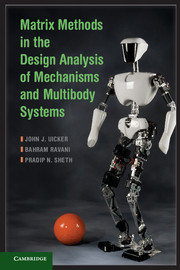Book contents
- Frontmatter
- Contents
- Preface
- About the Authors
- 1 Concepts and Definitions
- 2 Topology and Kinematic Architecture
- 3 Transformation Matrices in Kinematics
- 4 Modeling Mechanisms and Multibody Systems with Transformation Matrices
- 5 Posture Analysis by Kinematic Equations
- 6 Differential Kinematics and Numeric Solution of Posture Equations
- 7 Velocity Analysis
- 8 Acceleration Analysis
- 9 Modeling Dynamic Aspects of Mechanisms and Multibody Systems
- 10 Dynamic Equations of Motion
- 11 Linearized Equations of Motion
- 12 Equilibrium Posture Analysis
- 13 Frequency Response of Mechanisms and Multibody Systems
- 14 Time Response of Mechanisms and Multibody Systems
- 15 Collision Detection
- 16 Impact Analysis
- 17 Constraint Force Analysis
- Index
- References
10 - Dynamic Equations of Motion
Published online by Cambridge University Press: 05 April 2013
- Frontmatter
- Contents
- Preface
- About the Authors
- 1 Concepts and Definitions
- 2 Topology and Kinematic Architecture
- 3 Transformation Matrices in Kinematics
- 4 Modeling Mechanisms and Multibody Systems with Transformation Matrices
- 5 Posture Analysis by Kinematic Equations
- 6 Differential Kinematics and Numeric Solution of Posture Equations
- 7 Velocity Analysis
- 8 Acceleration Analysis
- 9 Modeling Dynamic Aspects of Mechanisms and Multibody Systems
- 10 Dynamic Equations of Motion
- 11 Linearized Equations of Motion
- 12 Equilibrium Posture Analysis
- 13 Frequency Response of Mechanisms and Multibody Systems
- 14 Time Response of Mechanisms and Multibody Systems
- 15 Collision Detection
- 16 Impact Analysis
- 17 Constraint Force Analysis
- Index
- References
Summary
Introduction
Throughout earlier chapters we have carefully formulated our equations in a very general, multi-degree of freedom form. In fact, our only two limiting assumptions so far have been: (1) that all bodies of our system are totally rigid, allowing no deformation or deflection, and (2) that all joints act precisely as described by their mathematical models shown in section 4.6, exhibiting no effects such as backlash or clearances. Indeed, our efforts have produced a kinematic model of our system that is extremely general and powerful. Even though its solution may be tedious for hand calculation, we recognize that evaluation is intended by digital computation and we hope to continue this generality and precision throughout our work in dynamics.
Lagrange's Equation
Although it may be possible to formulate the equations of motion for a general dynamic system by sketching free-body diagrams, assigning sign conventions and notation, and applying Newton's laws, such an approach is not used here because we are interested in complex and diversified three-dimensional mechanisms and multibody systems and our focus is on developing methods that can be coded for computation in a general setting. An approach based on energy and Lagrange's equation is adopted here, which results in a very general form and minimizes the potential for errors in formulation. Before we discuss the method, however, let us review a very brief history of energy methods in mechanics.
- Type
- Chapter
- Information
- Publisher: Cambridge University PressPrint publication year: 2013



